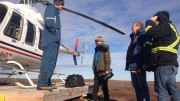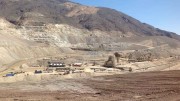“There’s a lot of moose pasture up here,” Mark Jarvis, president and CEO of Hard Creek Nickel (HNC-T), jokes while looking out at the gently rolling hills littered with pines aboard a short flight to the company’s Turnagain nickel project in north-central B.C.
But as the single-prop plane gets closer to the confluence of the fast-flowing Turnagain River and the meandering Hard Creek, Jarvis points toward the 275-sq.-km Turnagain project, where he hopes one day to turn more than 1.2 billion tonnes of rock – grading 0.2% nickel and 0.014% cobalt – into one of the largest nickel sulphide mines in the world.
Jarvis and his team have been slowly but advancing the mega-project since taking control of the company in early 2004.
Previous management and predecessor companies began the work in 1996. Last November, the company potentially solved the project’s biggest hang-up – low nickel recovery – in a metallurgical breakthrough that “changed the world for us,” says Neil Froc, Hard Creek’s executive vice-president in charge of engineering and technical studies.
Having previously faced a substantial US$2.9-billion capital cost to develop the mine, including over US$800 million required to build a complex refinery, Hard Creek assembled a world-class team of metallurgists and advisors to help devise a more economical method of extraction.
They quickly discovered a solution to Hard Creek’s main problem – that nickel mineralization could not be easily separated from the magnesium sulphides in the ore – and were able to boost the concentrate grade from 4% to over 18%.
As Jarvis describes it, “Instead of trying to suppress the magnesium from floating on the concentrate, we went to dispersants, and it just worked a lot better. Most of the nickel industry suppresses the magnesium, but in this case dispersants work much, much better.
“Before, when we ground the rock, the magnesium minerals were forming – they were flocculating – like cotton candy around the [nickel-bearing] pentlandite. Then, when you floated the pentlandite, the magnesium minerals were being physically dragged into the concentrate.
“Using dispersants, the cotton candy just fell apart, and now when you float the pentlandite, it’s not dragging magnesium with it anymore. That’s the heart of the difference in the metallurgy.”
Froc explains that by using the dispersants, it “allowed us to float the sulphides and leave the bulk of the gangue behind. What we’re doing is floating the sulphides, predominantly pentlandite, which is nickel sulphides, and separating them from the silicate gangue. We’re then able to create a clean, high-grade concentrate around 18% nickel.”
Hard Creek is now completing further metallurgical testwork in order to optimize the process, and demonstrate the method works across the property’s different zones. The studies will be factored into an updated preliminary economic assessment (PEA) for the Turnagain project, with release anticipated this October.
It will be the fourth PEA Hard Creek will have completed for the project. It released the first in mid-2006; the second in late 2007 to incorporate an increase to the project’s resource estimate; and the third in early 2010, to account for changes to the project design and updated metal prices.
According to Jarvis, “The big difference, the huge difference, between this and the last PEA, is that we’re modelling the creation of a very nice [18%] concentrate to sell directly to smelters, whereas in the last PEA, we were modelling making a 4% concentrate and refining that on-site. So, the capex will be a lot lower, and the technical risk will be a lot lower . . . This is now a plain-vanilla operation. We can simply produce a concentrate for sale.”
Drilling 79,000 metres in 280 holes has outlined an extensive resource to date at Turnagain, and the deposit remains open at depth and to the north. Measured and indicated resources stand at 695 million tonnes of 0.21% nickel and 0.014% cobalt, while inferred resources add another 510 million tonnes of 0.19% nickel and 0.014% cobalt, all at a cut-off grade of 0.1% nickel.
Parts of the property are highly prospective for platinum group elements (PGE), providing further exploration and resource estimate upside. In 2008, exploration drilling in the Cliffs zone 2.5 km east of the main Horsetrail zone returned 37 metres grading 0.35% nickel, and 0.29 gram per tonne platinum and palladium combined. At the DJ and DB zones 3 km northwest of Horsetrail, drilling in 2006 outlined a PGE-bearing horizon with a minimum strike length of 1.1 km, with one drill hole returning 37 metres grading 0.59 gram platinum and palladium combined.
Covering most of an Alaskan-type ultramafic intrusion measuring 8 km by 3.5 km, the Turnagain deposit is elongate in shape and trends in a northwest direction. The ultramafic complex consists of a central, well-exposed dunite core, and an outer zone of less exposed wehrlite, olivine pyroxenite, pyroxenite and minor hornblende.
While some investors would like to see the company continue to drill off the project, with only $2.4 million in working capital as of March 31, Hard Creek’s Jarvis says he is wary of spending big on another drill program as capital markets remain tetchy. The company has done little drilling over the past three years, and this year hardly looks different, as the company focuses on improving its metallurgical test results and completing a ground-magnetic geophysical survey on the platinum- and palladium-bearing DJ and DB areas. According to Jarvis, increasing the project’s size is not a main concern right now. He does not see Hard Creek completing much, if any, drilling in 2011, until the new PEA comes out. And by then, winter might have set in up north.
When asked about a near-term upside for investors not necessarily looking for a long-term story, Jarvis turned to the PEA update as Hard Creek’s main growth-driver this year. “We think the upcoming PEA is going to show a very robust project. Our market capitalization right now is fairly low . . . around $25 million. We feel like if we come up with some hard numbers and show that the project’s economics are robust, on a very simple processing circuit, then the market will revalue this thing.”
Hard Creek’s last PEA for Turnagain outlined an open-pit mining operation with a milling rate of 87,000 tonnes per day producing 35,000 tonnes, or 77 million lbs., of payable nickel per year. Operating costs came in at US$3.34 per lb. based on a conventional flotation system, a chloride leach process and on-site refining. Using base-case metal prices of US$8.50 per lb. nickel and US$17.50 per lb. cobalt, the project’s net present value was estimated at US$819 million, at an 8% discount rate. The company could produce 1.88 billion lbs. nickel over a 24.4-year mine life, boasting a life-of-mine strip ratio of 0.74-to-1.
Besides building a previously untried type of refinery on-site, the biggest roadblock presented by the PEA was the project’s US$2.95-billion capital cost, resulting in a 7.8-year payback period and an 11% internal rate of return.
In the new PEA, Hard Creek should be able to factor in the new method of recovery and a much higher nickel concentrate grade, the US$814-million cost of building a refinery. Off-site infrastructure costs previously totalling US$319 million, which would include extending the Northwest Transmission Line 250 km north from Bob Quinn, also could be lowered significantly. A positive construction decision by Imperial Metals (III-T) at its Red Chris copper-gold project near Iskut, B.C., would shorten Hard Creek’s transmission line extension to less than 150 km. According to Hard Creek’s Froc, the company is hoping to lower Turnagain’s anticipated capital expenditure to US$1.5 billion, with estimated capital costs already lowered to US$1.8 billion.
Nickel – a major component in stainless
steel – has lagged behind several base metals over the past year, and trades for around US$11 per lb., up from US$9 per lb. a year ago. This is still well below the metal’s 2007 highs of US$23 per lb., but up from its late 2008 low of $4.50. As Jarvis sees it, nickel prices will continue to trade above US$9, but below US$15 in the medium term.
“The market for nickel, to me, is largely driven by cost factors. For one thing, very few new nickel sulphide deposits are coming on stream. Most of the new nickel coming on-stream is from laterites, and laterites are expensive, and some of them are very technically tricky.
“Where are the greenfield projects that can be profitable at US$9 nickel, if you’re starting from scratch? And it’s difficult for nickel to get much over US$14 or US$15 per pound, because when the price goes up, the production of pig nickel in China accelerates, whereas under US$10, the margins for making pig nickel get very, very skinny, because of high energy costs.”
Shares of Hard Creek have drifted alongside nickel this year, and sit around the 30¢ level. The company has 77.3 million shares outstanding, 90.6 million if fully diluted, and a 52-week share price range of 19¢-57¢.






Be the first to comment on "Metallurgical breakthrough lifts Hard Creek’s Turnagain"